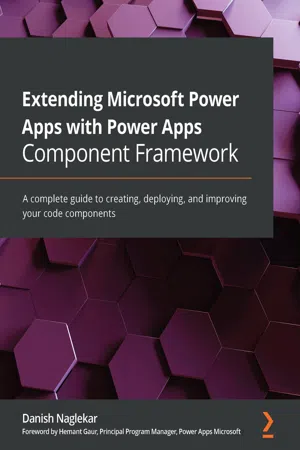
Extending Microsoft Power Apps with Power Apps Component Framework
A complete guide to creating, deploying, and improving your code components
- 318 pages
- English
- ePUB (mobile friendly)
- Available on iOS & Android
Extending Microsoft Power Apps with Power Apps Component Framework
A complete guide to creating, deploying, and improving your code components
About this book
Learn how to extend the capabilities of Power Apps by building code components using Power Apps Component Framework
Key Features
- Understand how to extend Power Apps' capabilities
- Enhance your skills with the help of practical code components used throughout the book
- Overcome common challenges, avoid pitfalls, and improve your code
Book Description
Power Apps Component Framework is used by professional developers to extend the capabilities of model-driven and canvas apps. Extending Microsoft Power Apps with Power Apps Component Framework will take you through the basic as well as advanced topics using practical examples.
The book starts by helping you understand the fundamentals of the framework, its lifecycle, and the tools that you'll use to build code components using best practices and file management guidelines. You'll then learn how to extend Power Apps step by step and apply the principles and concepts covered in the book to build code components for field type attributes. The book covers different ways of debugging code components and guides you through the process of building code components for datasets. You'll also explore the functions and methods provided by the framework to enhance your controls using powerful sets of libraries and extensions. As you advance, you'll get to grips with creating and managing authentication profiles, discover different ways of deploying code components, and configure code components in model-driven and canvas apps. Finally, you'll learn some of the important features of the framework and learn modern web development practices.
By the end of this Power Apps book, you'll be able to build, debug, enrich, and deploy code components confidently.
What you will learn
- Understand the fundamentals of Power Apps Component Framework
- Explore the tools that make it easy to build code components
- Build code components for both a field and a dataset
- Debug using test harness and Fiddler
- Implement caching techniques
- Find out how to work with the Dataverse Web API
- Build code components using React and Fluent UI controls
- Discover different deployment strategies
Who this book is for
This book is for developers who are looking to build advanced skills for extending the capabilities of Power Apps. Basic knowledge of Power Apps and web development is necessary to get started with this book.
Frequently asked questions
- Essential is ideal for learners and professionals who enjoy exploring a wide range of subjects. Access the Essential Library with 800,000+ trusted titles and best-sellers across business, personal growth, and the humanities. Includes unlimited reading time and Standard Read Aloud voice.
- Complete: Perfect for advanced learners and researchers needing full, unrestricted access. Unlock 1.4M+ books across hundreds of subjects, including academic and specialized titles. The Complete Plan also includes advanced features like Premium Read Aloud and Research Assistant.
Please note we cannot support devices running on iOS 13 and Android 7 or earlier. Learn more about using the app.
Information
Section 1: Fundamentals of the Power Apps Component Framework
- Chapter 1, Introduction to the Power Apps Component Framework
- Chapter 2, Power Apps CLI
- Chapter 3, Community Tools and Resources
- Chapter 4, Project Overview and the Component Life Cycle
Chapter 1: Introduction to the Power Apps Component Framework
- Overview of the Power Apps component framework
- Understanding the difference between the Power Apps component framework and HTML web resources
- Getting to know the licensing requirements
- Exploring the advantages of the Power Apps component framework
- Preparing your development machine
Learning some terminology
Overview of the Power Apps component framework
What is the Power Apps component framework?
Who is it focused on?
Table of contents
- Extending Microsoft Power Apps with Power Apps Component Framework
- Foreword
- Preface
- Section 1: Fundamentals of the Power Apps Component Framework
- Chapter 1: Introduction to the Power Apps Component Framework
- Chapter 2: Power Apps CLI
- Chapter 3: Community Tools and Resources
- Chapter 4: Project Overview and the Component Life Cycle
- Section 2: Building and Managing Code Components
- Chapter 5: Code, Test, and Repeat
- Chapter 6: Debugging Code Components
- Chapter 7: Authentication Profiles
- Chapter 8: Introduction to the Dataverse Project
- Chapter 9: Configuring Code Components in Power Apps
- Section 3: Enhancing Code Components and Your Development Experience
- Chapter 10: Diving Deep into the Features Provided by PCF
- Chapter 11: Creating Advanced Dataset Code Components
- Chapter 12: Enriching Your Dev Experience
- Answers to Knowledge Tests
- Other Books You May Enjoy